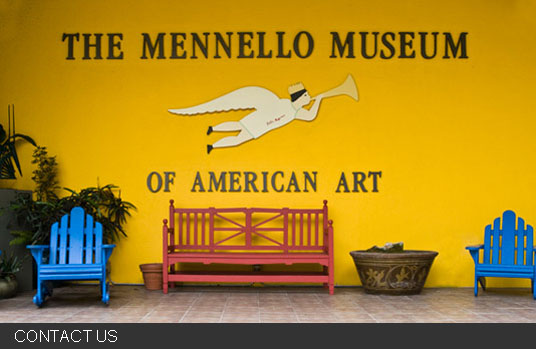-
Mennello Museum of American Art
Orlando, FL
Among the Mennello Museum of American Art’s many treasures is the permanent collection of paintings by self-taught artist Earl Cunningham, which was donated from the collection of Michael and Marilyn Mennello.
The Mennello Museum houses the largest collection of work by artist Earl Cunningham (1893-1977). The founding of the permanent collection is based on Cunningham’s work assembled by collectors Michael and Marilyn Mennello of Winter Park, Florida. In November 1998, in partnership with the Mennellos, the City of Orlando opened a new museum with this collection, The Mennello Museum of American Art in Loch Haven Cultural Park in Orlando, Florida.
Earl Cunningham was born in Edgecomb, Maine, near Boothbay Harbor, and from his birth was attracted to the sea. This love of the ocean defined both his life and his paintings. Cunningham left home at age 13 and supported himself as a tinker. He later became a seaman and traveled the East coast of the United States in large ships carrying goods to eastern ports. During World War II, he became a chicken farmer in Georgia raising chickens for the U.S. Army and many of his paintings were painted during that time.
In 1949, Cunningham settled in St. Augustine, Florida, and opened a curio shop called “The Over-Fork Gallery” where he continued to paint in relative obscurity. In his spare time, he painted genre scenes, primarily landscapes of the places he saw during his lifetime: Maine, New York, Nova Scotia, Michigan, North and South Carolina, Georgia and Florida. He was focused on creating a safe harbor for his many diverse inhabitants throughout his life and as reflected in recurring narrative.
A loner from an early age and self-taught as an artist, Earl Cunningham combines fact, fantasy and his own life experiences in paintings filled with vibrancy and confidence of life itself. His work reflects his own unique vision of the world and his naïve style speaks of joy and happiness. His glorious, vivid colors have given him the reputation of being an American Primitive Fauve.
Since his death in 1977, Cunningham’s work has received an overwhelming amount of attention and he has secured a place as a major Twentieth Century American Folk artist. In 1986, The National Museum of American Art, New York, launched a national tour of his works and in 2007 the Smithsonian American Art Museum presented the solo exhibition Earl Cunningham’s America. Since then, his paintings have been shown throughout the country and many museums have also acquired his work, including The Metropolitan Museum of Art in New York, the National Museum of American Art, Smithsonian American Art Museum, and the Abby Aldrich Rockefeller Folk Art Center, Williamsburg, Virginia.
New York Times art critic, Roberta Smith described his work as: "Fantastic, a weird fusion of traditional folk art and pop culture. [Cunningham’s] world is not only fabulously Technicolored, with skies tending toward hot pinks and yellows, and rivers and bays toward red or brown or ochre. It also teems with bright, often closely observed flora and fauna … all rendered in unexpected textures and often ingenious brushwork.” (R. Smith, New York Times, February 17, 1995)
Credit: Exhibition overview from museum website
Exhibition Venues & Dates
-
Mennello Museum of American Art
Orlando, FL
